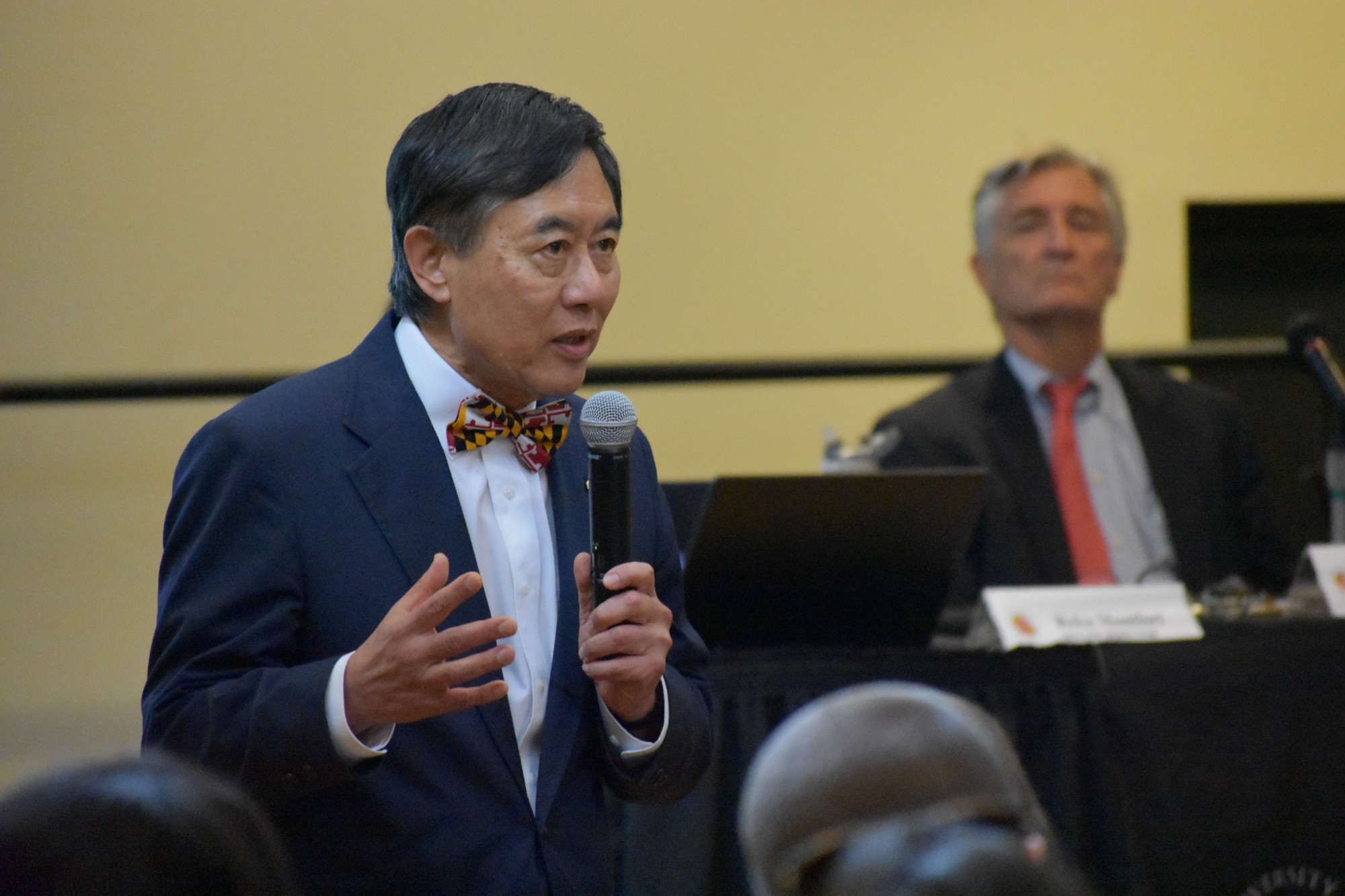At a University of Maryland Senate meeting Tuesday, university President Wallace Loh doubled down on statements that he knew nothing of abusive behavior by officials in the football program prior to media reports.
Following the death of 19-year-old offensive lineman Jordan McNair from heatstroke, ESPN and The Washington Post have reported a “toxic culture” driven by football coach DJ Durkin.
“I’m very closely interacting with students. I’ve got thousands following me on Twitter,” Loh said. “I had never ever heard that there was abuse of that sort at Maryland. As soon as I heard about it, I formed a commission to look into it.”
According to The Washington Post, the mother of a former Maryland football player wrote and hand-delivered a letter to Loh’s office detailing abuse within the program. She also sent an email to the office of Kevin Anderson, who was the athletic director at the time.
[Read more: UMD President Loh defends athletic department policies after Jordan McNair report]
Since McNair’s death, Loh said the university has implemented recommendations from sports medicine consultant Rod Walters, who helmed a university-contracted investigation into the athletic department’s safety protocols. This includes conducting hydration testing before workouts and offering more frequent recovery periods during workouts.
Walters’ report detailed the failure of football trainers to recognize the severity of McNair’s condition, and to submerge him in an ice bath, which has a 100 percent success rate in treating heatstroke when administered quickly. The trainers feared McNair would drown if they put him in an ice bath, since he was larger than they were, the report said.
The school has also purchased a device that will measure how many fluids and electrolytes athletes lose by the end of a workout. Athletes will then be expected to replenish them at the team’s training facility, Loh said.
Ben Reichard, a senior government and politics major, said Loh’s response was promising.
“His whole [response] has been very reactionary, so it was great to hear all these specific technical things to how they’re going to prevent this in the future,” he said. “But there are still a lot of questions.”
[Read more: Despite mounting evidence, top boosters stand by Maryland football’s DJ Durkin]
During his speech, Loh also offered updates on the university’s $1.5 billion fundraising campaign, and its hiring process for a new vice president of diversity and inclusion and Title IX officer.
As of Monday, the university had garnered $975 million toward its fundraising goal, Loh said. When the campaign was announced in May, it had already brought in $902 million.
Officials have said they’re aiming to hit the $1.5 billion mark by the end of 2021. The campaign truly began four years ago, and it includes the money donated for the Brendan Iribe Center for Computer Science and Cole Field House construction projects, as well as last year’s historic donation from the A. James and Alice B. Clark Foundation.
The campaign is also working to match the Clarks’ $50 million scholarship fund for students with financial need.
“We will transform the student experience with technology-enhanced education and real-world experiences to prepare students for 21st century success,” according to the campaign’s website.
The university is starting its search this month for new heads of the Office of Civil Rights and Sexual Misconduct and the Office of Diversity and Inclusion, Loh said.
Catherine Carroll, the former Title IX officer, resigned in August. She now works for Fairfax County Public Schools. Carroll, the office’s founding director, didn’t give a reason for stepping down this summer.
Earlier in her tenure, Carroll spoke out about the office’s funding, calling for more resources to investigate campus sexual misconduct and discrimination cases.
Warren Kelley, the assistant vice president for student affairs, and Lucy Dalglish, the journalism college dean, will co-chair the search committee for the new Office of Diversity and Inclusion director. The position will be elevated to vice presidential status, Loh said.
Kelley said the Senate hasn’t officially tasked the pair with leading the search, but the two previously served as co-chairs of the Joint President/Senate Inclusion and Respect Task Force, which developed recommendations that will be implemented partly by the vice president once they are hired.
In July, after just over a year on the job, Roger Worthington stepped down from the position of the interim chief diversity officer, and was replaced temporarily by Cynthia Edmunds.
Loh also said that over the past year and a half, the university has spent $19 million in improving diversity and inclusion efforts across campus.
“We have invested almost $19 million into diversity and inclusion, not all of it into the Office of Diversity and Inclusion,” Loh said. “Diversity and inclusion goes into every office, every department. It is not centralized to just the Office of Diversity and Inclusion, and that’s why you can’t really find that.”
During the meeting, Stephen Kenny, a sophomore government and politics major, questioned Loh about Maryland Today, specifically, about concerns that students cannot unsubscribe from the daily emails from university communications officials.
“I’m not tech savvy, but surely there must be a method of unsubscribing,” Loh said. “Most universities also have an internal communications work. Most universities have something equivalent.”



